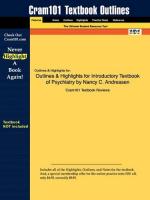|
This section contains 377 words (approx. 2 pages at 300 words per page) |
World of Genetics on Nancy C. Andreasen
Nancy C. Andreasen is an author and professor of psychiatry known for her investigations relating mental illness to the biological processes of the brain. She was the first to use populations, such as twins to disentangle genetic and environmental interactions. Andreasen's work utilizes a variety of neuroimaging techniques for three-dimensional reconstruction, statistical analysis, and automated measurements.
Born in Lincoln, Nebraska, Andreasen began her first academic career with a B.A. in English from the University of Nebraska. She received an M.A. from Radcliffe College, and a Ph.D. from the University of Nebraska. She became a Fulbright scholar at Oxford University in England then joined the English faculty at the University of Iowa as an assistant professor in 1963.
In 1966, Andreasen undertook her medical studies at the College of Medicine at Iowa. Four years later she received her M.D., and following residency in psychiatry, she returned to Iowa as an assistant professor of psychiatry.
In the late 1970s advances in computer science and imaging technology made it possible to examine the interior of a functioning human brain. Powerful techniques like magnetic resonance imaging (MRI), positive emission tomography (PET), and single photon emission computerized tomography (SPECT) allowed scientists to examine dynamic neural functions. The new technology inspired Andreasen to start an ambitious project to map both healthy and diseased brains.
Using family and twin studies, Andreasen demonstrated a potential genetic connection of schizophrenia as it resembles other complex illnesses, such as diabetes mellitus. The mental illness is nonmendelian, probably polygenic, and possibly multifactorial. Recent studies show possible loci associated with the disorder located on chromosomes 6, 9, and 20.
On December 1, 2000 Andreasen received a National Medal of Science, one of the United State's highest awards in science. Andreasen asserts that neurodevelopmental illnesses are problems grounded in molecular and cellular malfunctions.
Andreasen is author of more than 200 scientific articles and ten books. Her book The Broken Brain: The Biological Revolution in Psychiatry was written for the lay public. She has won numerous awards for the book, which is now regarded as a classic text in introductory psychology and neurobiology. Her book Brave New Brain: Conquering Mental Illness in the Era of the Genome relates how the principles of psychiatry and genetics are used by physicians to treat mental illness.
|
This section contains 377 words (approx. 2 pages at 300 words per page) |


